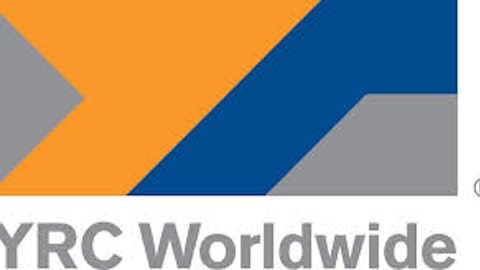Valeant Pharmaceuticals Intl Inc (NYSE:VRX) jumped 8% on Monday, giving the stock a two-day 22% surge. Those large gains stemmed from Valeant Pharmaceuticals Intl Inc (NYSE:VRX)’s acquisition of Bausch & Lomb for $8.7 billion, which is expected to expand Valeant Pharmaceuticals Intl Inc (NYSE:VRX)’s small ophthalmology business.

Most notably, on April 22 Valeant Pharmaceuticals Intl Inc (NYSE:VRX) acquired Obagi Medical Products for $24 a share, or $420 million, a deal that could lead to $120 million more in annual sales.
Creating Value Through Acquisitions
While Valeant Pharmaceuticals Intl Inc (NYSE:VRX) CEO Michael Pearson has always been very vocal regarding his acquisition growth strategy, the strategy itself appears less than stellar. To explain, let’s first take a look at a very different company with a similar growth strategy: XPO Logistics Inc (NYSE:XPO).
XPO Logistics Inc (NYSE:XPO), a truck brokerage company, had revenue of $177 million in 2011. But thanks to a string of purchases, it’s now on pace to post annual revenue of $600 million in 2013.
In 2012 alone, XPO Logistics Inc (NYSE:XPO) completed four acquisitions that added $253 million in annual revenue, at a collective cost of $62 million. XPO Logistics Inc (NYSE:XPO) then integrated the new revenue into its sales channel to produce additional growth.
Currently, XPO Logistics Inc (NYSE:XPO) is expanding rapidly with cold starts and is hiring more than 60 people per month. Therefore, its goal is growth, not profitability. After its growth period, costs will slow, and the company expects to maintain net profit margins between 5% and 10%.
XPO Logistics Inc (NYSE:XPO) CEO Bradley Jacobs has said that he only acquires companies that can be scaled up quickly to double in size. Therefore, if the $250 million of acquired revenue can become $500 million – with a net profit margin of 5% — then it’ll take just two and a half years for 2012’s acquisitions to return a profit for XPO Logistics.
An Acquisition Strategy That Lacks Value
In transportation, XPO can acquire companies cheaply relative to their revenue. But in biotechnology, those acquisitions are much more expensive. When it’s all said and done, profit is what will ultimately create value for shareholders. If a company’s acquisition does not create a profit, then the acquisition was a loss.
Valeant is buying well-established companies long beyond their growth phase. Bausch & Lomb will not produce large growth — but it does produce a net profit margin around 20%. Valeant’s other acquisition, Obagi, produces a net profit margin of 14%, also with limited to no growth. The chart below shows you how long it could take for these acquisitions to return a profit for shareholders.
| Metric | Bausch & Lomb | Obagi Medical |
|---|---|---|
| Expected Annual Sales | $3.3 billion | $120 million |
| Expected Net Profit Margin | 20% | 14% |
| Expected Annual Profit | $660 million | $17 million |
| Acquisition Price | $8.7 billion | $420 million |
| Years To Produce A Profit On Acquisition | 13.2 | 24.7 |
Valeant bulls will automatically look at the chart above and argue that Valeant can increase profit margins by combining sales teams and drug manufacturing operations. But even if Valeant could double the margins of these two acquisitions, it would still take more than six years and 12 years, respectively, for each acquisition to return a profit. In that time, the company could lose patents, gain generic rivals, and watch sales begin to fall drastically.
In my opinion, Valeant is playing a dangerous acquisition game in a very expensive industry. In the last two years, we have seen Pfizer, Bristol-Myers, and Amgen all made high-profile, expensive acquisitions. But Valeant has only a fraction of their cash position, and is leaving itself highly exposed to financial hardships.
Final Thoughts On The Acquisition Spree
Luckily for Valeant, there is great value in its stock. The company has seen its valuation increase 90% over the last year and has a market cap of $28 billion, despite producing annual sales of just $3.75 billion. Therefore, Valeant can use its stock to make acquisitions; use record low interest rates to accumulate debt; and issue new stock to fund its future purchases.
At the start of 2010, before Valeant started its string of buyouts, the company had total debt of just $326 million. Today, the company has total debt of $11 billion and a debt-to-assets ratio over 60%. With $14.2 billion in total liabilities and an accumulated deficit of $2.3 billion, its balance sheet is a nightmare.
Apparently, that nightmare won’t get any better. With a $8.7 billion acquisition ahead, an acquisition strategy that can take decades to return a profit, Valeant is setting itself up for future struggles. I won’t be along for the ride.
The article This Acquisition Spree Could Create Future Struggles originally appeared on Fool.com.
Brian Nichols owns shares of XPO Logistics. The Motley Fool has no position in any of the stocks mentioned. Brian is a member of The Motley Fool Blog Network — entries represent the personal opinion of the blogger and are not formally edited.
Copyright © 1995 – 2013 The Motley Fool, LLC. All rights reserved. The Motley Fool has a disclosure policy.



